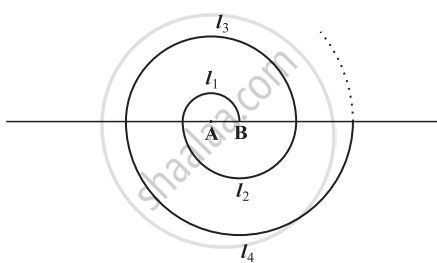Advertisements
Advertisements
प्रश्न
A spiral is made up of successive semicircles, with centres alternately at A and B, starting with centre at A of radii 0.5, 1.0 cm, 1.5 cm, 2.0 cm, .... as shown in figure. What is the total length of such a spiral made up of thirteen consecutive semicircles? (Take `pi = 22/7`)

[Hint: Length of successive semicircles is l1, l2, l3, l4, ... with centres at A, B, A, B, ... respectively.]
उत्तर
Length of a semi-circle
= semi circumference = `1/2 (2pir) = pir`
l1 = πr1 = 0.5 π cm = 1 × 0.5 π cm
l2 = πr2 = 1.0 π cm = 2 × 0.5 π cm
l3 = πr3 = 1.5 π cm = 3 × 0.5 π cm
l4 = πr4 = 2.0 c cm = 4 × 0.5 π cm
l13 = πr13 = 13 × 0.5 π cm = 6.5 π cm
Now, length of the spiral = l1 + l2 + l3 + l4 + ... + l13
= 0.5 π [1 + 2 + 3 + 4 + ... + 13] cm ....(1)
∴ 1, 2, 3, 4, ...., 13 are in AP such that
a = l and l = 13
∴ `S_13 = 13/2 [1 + 13] ....["Using" S_n = n/2 (a + l)]`
= `13/2 xx 14`
= 13 × 7
= 91
∴ From (1), we have:
Total length of the spiral = 0.5 π [91] cm
= `5/10 xx 22/7 xx 91` cm
= 11 × 13 cm
= 143 cm
APPEARS IN
संबंधित प्रश्न
The sum of the first p, q, r terms of an A.P. are a, b, c respectively. Show that `\frac { a }{ p } (q – r) + \frac { b }{ q } (r – p) + \frac { c }{ r } (p – q) = 0`
Find the sum given below:
34 + 32 + 30 + ... + 10
In an AP given a = 8, an = 62, Sn = 210, find n and d.
How many terms of the AP. 9, 17, 25 … must be taken to give a sum of 636?
Find the sum of all 3 - digit natural numbers which are divisible by 13.
Find the sum of all odd natural numbers less than 50.
If the sum of first m terms of an AP is ( 2m2 + 3m) then what is its second term?
If (2p – 1), 7, 3p are in AP, find the value of p.
Draw a triangle PQR in which QR = 6 cm, PQ = 5 cm and times the corresponding sides of ΔPQR?
If the common differences of an A.P. is 3, then a20 − a15 is
The first and the last terms of an A.P. are 8 and 350 respectively. If its common difference is 9, how many terms are there and what is their sum?
Write the value of a30 − a10 for the A.P. 4, 9, 14, 19, ....
Write the value of x for which 2x, x + 10 and 3x + 2 are in A.P.
If \[\frac{5 + 9 + 13 + . . . \text{ to n terms} }{7 + 9 + 11 + . . . \text{ to (n + 1) terms}} = \frac{17}{16},\] then n =
The given terms are 2k + 1, 3k + 3 and 5k − 1. find AP.
Q.1
Find the sum of first 20 terms of an A.P. whose first term is 3 and the last term is 57.
The sum of first ten natural number is ______.
Show that the sum of an AP whose first term is a, the second term b and the last term c, is equal to `((a + c)(b + c - 2a))/(2(b - a))`
Assertion (A): a, b, c are in A.P. if and only if 2b = a + c.
Reason (R): The sum of first n odd natural numbers is n2.
